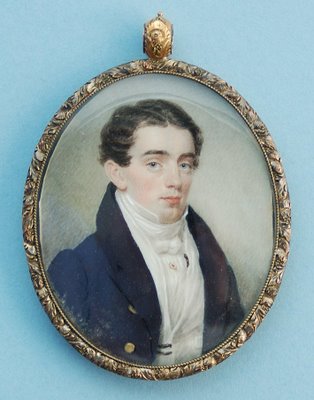
Sarah Goodridge (1788-1853) was born in a small village in Massachussetts, the sixth of nine children. Growing up in the country, she learned to draw by scratching pictures with a pin on birch bark. Eventually she made her way to Boston where she earned a living painting miniature portraits on ivory.

In the days before photography, such pictures were often worn in lockets or pinned to lapels.

Goodridge's miniatures were very popular and she soon flourished as an independent artist-- a rarity for a woman in colonial America. By painting two or three portraits a week, she made enough to support her sick mother, her orphan niece, and other family members. Her career lasted for thirty years until her failing eyesight forced her to stop. She never married.
Goodridge did, however, develop a special friendship with the handsome young Boston lawyer Daniel Webster. The first time she painted Webster's portrait, he was married with three children. He sat for eleven more portraits over the next 25 years. Webster and Goodridge wrote each other frequently; she carefully preserved letters from him, while he seems to have carefully destroyed letters from her. When he moved to Washington to serve in government she visited him there twice.
After Webster's wife died in 1827, Goodridge secretly painted this miniature for him entitled Beauty Revealed (self portrait):

Sarah's daring self-exposure was unthinkable in an era when modesty was carefully preserved by several layers of clothing. Her painting crossed all kinds of boundaries-- social, sexual, religious and artistic. John Updike describes this little jewel as "the first known nude American portrait done from life."

No one can ever be certain what Webster and Goodridge shared in private. Scholars have agreed that at a minimum, Goodridge's self-portrait told Webster, in the words of Updike, "we are yours for the taking."
Could an object so small ever carry greater weight? Sarah's offering is not mere pigment on ivory. It shows how an artist invests a physical object with deep significance, and through that object reaches out to another human. It reminds me of Walt Whitman's impassioned effort to use a poem to reach beyond his mortality and touch some future reader who might be holding Leaves of Grass late at night:
Now lift me close to your face till I whisper,Whatever their private relationship, Webster was politically ambitious and needed money, so Goodridge simply would not do for his second wife. He met and quickly married another woman, whose sole qualification seemed to be that she was from a wealthy and prominent family.
What you are holding is in reality no book,
nor part of a book;
It is a man, flush'd and full-blooded -- it is I -- So long!
We must separate awhile --
Here! take from my lips this kiss;
Whoever you are, I give it especially to you;
When Goodridge died, she left her beloved paint box to Webster.
As for Webster, he kept her tiny painting hidden amongst his personal effects until the day he died. It was discovered by his heirs and was eventually sold off.
This miraculous glimpse of a beating heart beneath the manners and undergarments of an earlier generation is now safely contained in an antiseptic museum showcase.

14 comments:
Sexy, sweet, and sad.
I love the "Artists in Love" series!
Thanks, Irene. It seems that art sometimes helps and sometimes hinders the path of love. But one thing's for sure: when you combine two of the best aspects of being human, you get one interesting chemistry experiment.
I'm glad you featured this type of ephemera. Illustrations from these sources is often under-appreciated. I feature similar ephemera on my blog at www.ephemera.typepad.com
I enjoy your blog and thought this was a very cool post. Thanks for featuring it.
I wonder sometimes if those who love in secret could or would survive in full sunlight. Might the very element that makes illicit love so intense be the limitations and restrictions imposed? No emotions are diluted by the mundane ritual of daily life when they exist primarily in the imagination, or on the artist's palette. -pcp
PS pretty nice gift she gave him.... pcp
Thanks, Marty. I just checked out your blog and enjoyed it very much.
Pcp, I agree this was a darned nice gift. Lovely and poignant and in the end, heart breaking.
Fantastic choices of artwork again. And a heartbreaking story.
I also really enjoy this "series". They almost always have this bitter sweet quality to them, unrequited love. You wouldn't happen to be a sad romantic yourself, would you?
So it looks like that "long-barreled, slab-sided, lantern-jawed, fortunetelling note shaver!" (i.e. the devil) -- finally did get the best of Daniel Webster.
For some OTHER interesting artists of portrait miniatures, and their sometimes eccentric and always engaging sitters, take a look at www.archibaldminiatures.com. Portrait miniatures are complex artworks, for they have an intimate facet to them; most were commissioned by the sitters to give to loved ones.
Love this wonderful post-Sarah Goodridge's paintings-wow-Her self-portrait oozes passion as does all her paintings & yours too for pure passion for the subject. Many thanks.
Very interesting, love the whole serie "Artists in love", and this one about sarah goodridge in particular. is there more detailed bio of her? I'd like to know more about her life.. maybe some researches?
Thanks, Xenya-- I didn't find much about Sarah back when I wrote this. I stumbled across her little painting and could only track down a couple of obscure articles about her. I'm sure that eventually, legitimate scholars will give her the attention she deserves.
Post a Comment